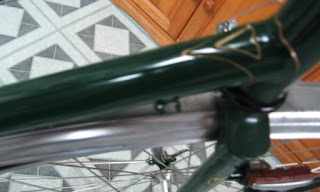I'm still debating what to do with Marianela. I don't think selling her will bring enough money to make it worthwhile. I suppose I still could donate her, which might be a halfway noble thing to do.
But even that doesn't seem feasible, in a way. When I donated the Bridgestone Mountain Bike, at least it was a bike that its intended recipient--an immigrant who's working in construction, landscaping, restaurants or wherever else they need cheap labor--would be happy to get. It's in a fairly common size, albeit a little bigger than the mountain bikes I used to ride. And, not having suspension but having good, basic components, it makes a a good transport bike and is not overly complicated or esoteric.
However, mixte frames of any quality are hard to come by in Marianela's size. My two Mercian mixtes are both custom frames--one (Helene) built for me and the other (Miss Mercian II) built for Pete, from whom I bought it. Just as most clothing manufacturers still seem to think that women don't need inseams of more than 30 inches, bike makers seem to think either that there aren't any women over 5'6" or that those of us who are taller are just men with a couple of different parts.
So, the fact that it's a tall mixte is almost, by itself, reason to keep Marianela, even if Miss Mercian II becomes my commuter. I could keep Marianela locked up outside, so the limited space in my apartment wouldn't be an issue. And, as I mentioned earlier, I think that there will still be times when she'll come in handy.
If I keep her, though, I might get a pair of plastic fenders to replace the ones I took from her. They wouldn't be as pretty as the fenders (Velo Orange Zeppelins) I had on the bike, but they might be more practical for a bike that's going to be parked on the streets and not well cared-for.
I would definitely need to replace the seat, though. Right now, she has the one that came with Miss Mercian II. That seat is one I wouldn't ride in any case, and it's entirely unsuited for upright bars. I suppose I could buy a Brooks B-67 or something similar for MMII and return the Gyes to Marianela. But the Gyes is pretty well broken-in and I don't want to take the time to break in another saddle. Besides, something cheap, and possibly made of synthetic materials, just might make more sense on a bike I'm going to leave on the streets.










